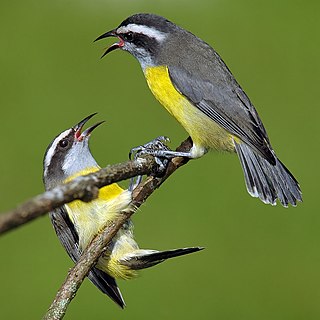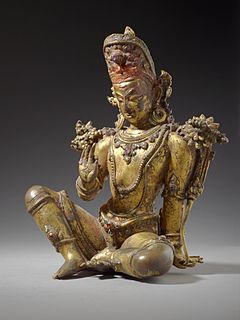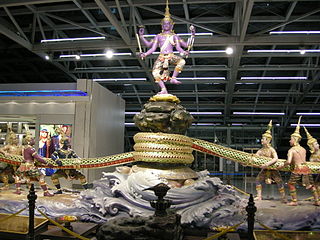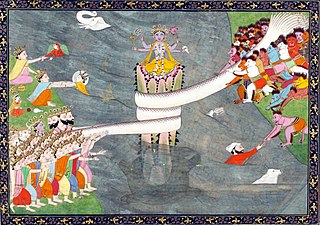
Asuras are a class of beings or power-seeking clans related to the more benevolent Devas in Hinduism.
Hindu deities are the gods and goddesses in Hinduism. The terms and epithets for deity within the diverse traditions of Hinduism vary, and include Deva, Devi, Ishvara, Ishvari, Bhagavān and Bhagavati.

Kurma, also known as 'KurmaRaja' is an avatar of the Hindu god Vishnu. Originating in Vedic literature such as the YajurVeda as being synonymous with the Saptarishi called Kasyapa, Kurma is most commonly associated in post-Vedic literature such as the Puranas with the legend of the churning of the Ocean of Milk, referred to as the Samudra manthan. Also synonymous with Akupara, the world-turtle supporting the Earth, Kurma is listed as the second incarnation of the Dashavatara, the ten principal avatars of Vishnu.

The bananaquit is a species of passerine bird in the tanager family Thraupidae. Before the development of molecular genetics in the 21st century, its relationship to other species was uncertain and it was either placed with the buntings and New World sparrows in the family Emberizidae, with New World warblers in the family Parulidae or in its own monotypic family Coerebidae. This small, active nectarivore is found in warmer parts of the Americas, and is generally common.

Deva means "heavenly, divine, anything of excellence", and is also one of the terms for a deity in Hinduism. Deva is a masculine term; the feminine equivalent is Devi.

Mahishasura was a buffalo Asura in Hinduism. He is known among Hindus of most sects as a deceitful demon who pursued his evil ways by shape-shifting. Mahishasura was the son of Rambha, and the great-grandson of Brahmarshi Kashyapa. He was ultimately killed by Goddess Durga - after which She gained the epithet Mahishasuramardini. The Navaratri festival eulogizes this battle between Mahishasura and Durga, culminating in Vijaya Dasami, a celebration of his ultimate defeat. This story of the "triumph of Good over Evil" carries profound symbolism in Hinduism, particularly Shaktism, and is both narrated as well as reenacted from the Devi Mahatmya at many South- and Southeast Asian Hindu temples. The story is also told in the Sikh text Chandi di Var, also called Var Durga Di, which many in Sikh tradition believe was included in the Dasam Granth by Guru Gobind Singh.

A daeva is a Zoroastrian supernatural entity with disagreeable characteristics. In the Gathas, the oldest texts of the Zoroastrian canon, the daevas are "gods that are rejected". This meaning is – subject to interpretation – perhaps also evident in the Old Persian "daiva inscription" of the 5th century BCE. In the Younger Avesta, the daevas are divinities that promote chaos and disorder. In later tradition and folklore, the dēws are personifications of every imaginable evil.

The Samudra Manthana is one of the best-known episodes in the Hindu philosophy narrated in the Bhagavata Purana, in the Mahabharata and in the Vishnu Purana. The Samudra Manthana explains the origin of Amrita, the nectar of immortality and the omnipotent god of destruction Shiva drank the vish.

The saffron finch is a tanager from South America that is common in open and semi-open areas in lowlands outside the Amazon Basin. They have a wide distribution in Colombia, northern Venezuela, western Ecuador, western Peru, eastern and southern Brazil, Bolivia, Paraguay, Uruguay, northern Argentina, and Trinidad and Tobago. It has also been introduced to Hawaii, Puerto Rico and elsewhere. Although commonly regarded as a canary, it is not related to the Atlantic canary. Formerly, it was placed in the Emberizidae but it is close to the seedeaters.

An asura in Buddhism is a demigod or titan of the Kāmadhātu. They are described as having three heads with three faces each and either four or six arms.

The yellow tyrannulet is a very small passerine bird in the tyrant flycatcher family. It breeds from Nicaragua south to northeastern Argentina and southeastern Brazil. It is the only member of the genus Capsiempis, but its taxonomy is uncertain, and it has been allocated to at least three other genera in the past.

In Hindu cosmology, the Ocean of Milk is the fifth from the center of the seven oceans. It surrounds the continent known as Krauncha. According to Hindu scriptures, the devas and asuras worked together for a millennium to churn the ocean and release Amrita the nectar of immortal life. It is spoken of in the Samudra manthana chapter of the Puranas, a body of ancient Hindu legends. It is called as Thirupaarkadal in Tamil and is the place where Vishnu reclines over Shesha Naga along with his consort Lakshmi.
The Kālakeyas or Kālakhañjas are a class of Asura in Hindu mythology. They were a powerful, ferocious and cruel clan of the Dānavas.

Asura is a genus of moths in the subfamily Arctiinae erected by Francis Walker in 1854.
Gakuto Mikumo is a Japanese writer of mystery and science fiction light novels from the Oita Prefecture in Japan. He is a member of the Mystery Writers of Japan and the Honkaku Mystery Writers Club of Japan.

Asura's Wrath is an action video game developed by CyberConnect2 and published by Capcom. Asura's Wrath was first announced at the Tokyo Game Show in 2010, and was released worldwide in February 2012. The game is playable on PlayStation 3, Xbox 360, Xbox One via 360 backwards compatibility, and the PlayStation 4 and PC via PlayStation Now.
Asura quadrilineata is a moth of the family Erebidae. It is found on Aru and in Australia.

Cyme sexualis is a moth of the subfamily Arctiinae first described by Felder in 1864. It is found on Ambon, Sulawesi, the Dampier Archipelago. and in New Guinea.
Bitecta flaveola is a moth of the subfamily Arctiinae. It was described by Rothschild in 1912. It is found in New Guinea.
Liriomyza flaveola is a species of fly from Liriomyza genus, Agromyzidae family. It was described for first time by Fallén in 1823. According to Catalogue of Life Liriomyza flaveola does not have known subspecies.












